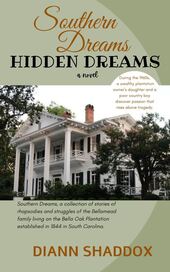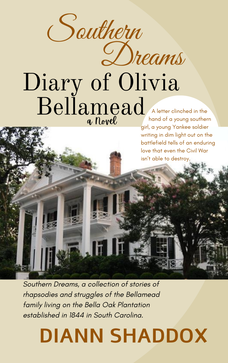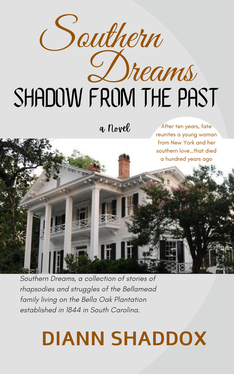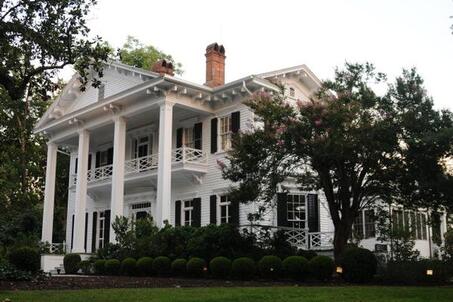Southern Dreams, a collection of stories on their own of rhapsodies and struggles of the Bellamead family living on the Bella Oak Plantation established in 1844 in South Carolina. Each generation of the Bellamead family chronicles events that weave the years to unite the tapestry of life.
Hidden Dreams set in the 1960's a stand alone book part of
Southern Dreams Series

Hidden Dreams, During the 1960s, a wealthy plantation owner’s daughter and a poor country boy discover passion that rises above tragedy.
It is a simpler time, an era blending over a hundred years of the past with the present. Surrounded by moss draped live oak trees is the huge Bella Oak verandah with paddle fans swishing overhead. Charlie, a spirited redheaded girl, and Jessie, a young artist who captures her in his drawings, find unconditional love.
Their lives should have been wonderful, but as most love stories unfold, life and fate take over. These are the days of their hidden dreams.
It is a simpler time, an era blending over a hundred years of the past with the present. Surrounded by moss draped live oak trees is the huge Bella Oak verandah with paddle fans swishing overhead. Charlie, a spirited redheaded girl, and Jessie, a young artist who captures her in his drawings, find unconditional love.
Their lives should have been wonderful, but as most love stories unfold, life and fate take over. These are the days of their hidden dreams.
Diary of Olivia Bellamead set in the 1800's
Part of Southern Dreams Series

Diary of Olivia Bellamead a love story. A letter clinched in the hand of a young Southern girl and a another letter being written in the dim light of a battlefield by a Yankee soldier tell of an enduring love that even the Civil War isn’t able to destroy.
It is a yarn that weaves and binds the North and the South into a noble tapestry. Southern Dreams begins one Fourth of July picnic in 1861 when Olivia Rose Bellamead, a young Southern belle, and Jackson Seth Montgomery, a vast plantation heir-apparent, were to be publically presented as an engaged couple, an arrangement made by her parents. However, a mysterious Northern stranger named Andrew Robert Drake arrived on the day of the picnic. He caught Olivia’s eye and that changed the course of both of their lives.
Andrew rode north that day leaving his love behind promising someday to come back. He, a surgeon in the Union army, sends her letters, tales from the battlefields, stories of young men: Northern and Southern alike, each with their blue or grey uniforms but both so bloody that the surgeon could not distinguish between the Rebels and the Yankees; he only cared about preserving life.
Olivia holds dear each letter she receives as she clings to her dreams of Andrew coming home. Struggling with death and destruction all around, she watches the South as it collapses to ruins. Looking out over her beloved Bella Oak plantation, she stands remembering the day she met Andrew and knowing that it was a time lost in the past, never to emerge again. She pulls out the unopened letter she has received, clinching it tightly. Her worst fear is that the letter would be one with different handwriting.
It is a yarn that weaves and binds the North and the South into a noble tapestry. Southern Dreams begins one Fourth of July picnic in 1861 when Olivia Rose Bellamead, a young Southern belle, and Jackson Seth Montgomery, a vast plantation heir-apparent, were to be publically presented as an engaged couple, an arrangement made by her parents. However, a mysterious Northern stranger named Andrew Robert Drake arrived on the day of the picnic. He caught Olivia’s eye and that changed the course of both of their lives.
Andrew rode north that day leaving his love behind promising someday to come back. He, a surgeon in the Union army, sends her letters, tales from the battlefields, stories of young men: Northern and Southern alike, each with their blue or grey uniforms but both so bloody that the surgeon could not distinguish between the Rebels and the Yankees; he only cared about preserving life.
Olivia holds dear each letter she receives as she clings to her dreams of Andrew coming home. Struggling with death and destruction all around, she watches the South as it collapses to ruins. Looking out over her beloved Bella Oak plantation, she stands remembering the day she met Andrew and knowing that it was a time lost in the past, never to emerge again. She pulls out the unopened letter she has received, clinching it tightly. Her worst fear is that the letter would be one with different handwriting.
Shadow From the Past set in today's time
Part of Southern Dreams Series
COMING SOON

Shadow From the Past is a mysterious love story set in modern times. Fate reunites a young woman from New York and her Southern admirer, who died heroically during the Civil War.
An old, charming southern plantation, Bella Oak, in South Carolina, the home of Jessie and Charlie Ledford, drew a young artist, Becca into its world, when she was sixteen. Now ten years later, Becca ponders many secrets from that summer so long ago, which she had managed to keep from Jordan, her fiancé. She would sit daydreaming and he believed it was because she was an artist, but unbeknownst to him, she was thinking of a young Southern boy, Benjamin Bellamead, who had stolen her heart years ago.
She wonders what the young boy, now a man, would be like. She learns that Bella Oak Plantation is for sale and she has to see the old plantation once more before it is sold. She plans her trip to South Carolina, but to her surprise, Jordon insists on driving down with her. She asks about Benjamin, astoundingly learning that he died in the Civil War and that the only other Benjamin is their grandson, Benjamin Jack, or BJ, but he wasn’t at Bella Oak the summer she visited.
The shocking facts she learns bewilder her, but she still did not share her secret with Jordan. Understanding that Benjamin the young boy she fell in love with was from another time. The only reason she had come back to Bella Oak was to find an old love, but instead, she finds a tangle web of hidden secrets she has to unravel.
An old, charming southern plantation, Bella Oak, in South Carolina, the home of Jessie and Charlie Ledford, drew a young artist, Becca into its world, when she was sixteen. Now ten years later, Becca ponders many secrets from that summer so long ago, which she had managed to keep from Jordan, her fiancé. She would sit daydreaming and he believed it was because she was an artist, but unbeknownst to him, she was thinking of a young Southern boy, Benjamin Bellamead, who had stolen her heart years ago.
She wonders what the young boy, now a man, would be like. She learns that Bella Oak Plantation is for sale and she has to see the old plantation once more before it is sold. She plans her trip to South Carolina, but to her surprise, Jordon insists on driving down with her. She asks about Benjamin, astoundingly learning that he died in the Civil War and that the only other Benjamin is their grandson, Benjamin Jack, or BJ, but he wasn’t at Bella Oak the summer she visited.
The shocking facts she learns bewilder her, but she still did not share her secret with Jordan. Understanding that Benjamin the young boy she fell in love with was from another time. The only reason she had come back to Bella Oak was to find an old love, but instead, she finds a tangle web of hidden secrets she has to unravel.


